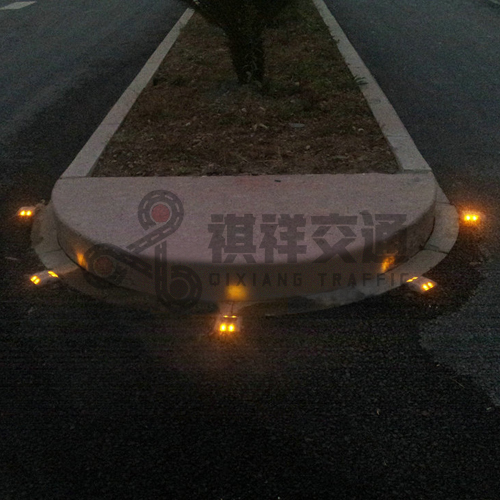Solar road studs, also known as solar road signs or solar cat eyes, are self-contained lighting devices embedded in the road surface. These small but powerful devices ensure the safety of drivers and pedestrians by providing clearly visible road alignment indications in low-light conditions.
The main purpose of solar road studs is to enhance road safety. They play a vital role in guiding drivers by marking road alignments, especially in areas where there are no street lights or where visibility is poor due to adverse weather conditions such as heavy rain or fog. By providing a clearly visible lane outline, solar road studs help prevent accidents, minimize the occurrence of lane departures, and improve overall road safety.
One of the main features of solar road studs is their ability to be powered entirely by solar energy. The devices are equipped with small solar panels that charge internal batteries during the day. The stored energy is then used to power high-intensity LED lights, which are extremely bright, energy-efficient, and long-lasting. The solar functionality of the road studs eliminates the need for external electrical connections, making installation and maintenance cost-effective and environmentally friendly.
Solar road studs are designed to be extremely durable and weather-resistant. They are made from materials such as aluminum alloy, polycarbonate, or epoxy resin, which makes them resistant to extreme temperatures, heavy loads, and vehicle impacts. Additionally, these studs are waterproof and can withstand a variety of weather conditions, including rain, snow, and intense heat. This durability ensures that solar road studs will function effectively and consistently year-round, enhancing road safety day and night.
The versatility of solar spikes is another factor that contributes to their purpose. The devices are available in a variety of colors, including white, yellow, blue, and red, and can be used to indicate different types of information. For example, white studs are often used to mark road boundaries or center lines, while red studs are often used to indicate potentially hazardous or prohibited areas. By using different colors, solar road studs can provide drivers with clear and easy-to-understand guidance, regardless of language or cultural differences.
In addition to guiding drivers, solar road studs have other benefits. They serve as effective warning devices on steep or dangerous road curves, at pedestrian crossings, or in accident-prone areas. By providing a visual alert, solar road studs can prompt drivers to slow down, be careful, and obey traffic rules. Additionally, these studs can act as markers during road construction, indicating detours or temporary traffic arrangements, minimizing confusion, and minimizing risks associated with construction activities.
The increased application of solar road studs is an important step towards achieving sustainable and smart transportation systems. By harnessing solar energy, these devices help reduce greenhouse gas emissions and promote the use of renewable energy. Their low energy consumption and long service life also reduce maintenance costs in the long term. In addition, the use of solar road studs is in line with the concept of smart cities, which use technology to improve the quality of life, efficiency, and safety of urban environments.
In summary, solar road studs play a vital role in improving road safety. By providing clear lanes and road alignments, these small but powerful devices can guide drivers in low-light conditions and inclement weather. Their solar capabilities, durability, and versatility make them ideal for a variety of road applications. Furthermore, solar road studs play an important role in enabling sustainable and smart transportation systems while ensuring the safety of drivers and pedestrians. It is therefore clear that solar road studs are valuable equipment to improve road safety and contribute to a greener, smarter future.
If you are interested in solar road studs, welcome to contact solar road stud factory Qixiang to read more.
Post time: Nov-28-2023







